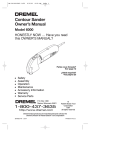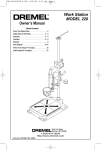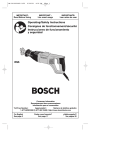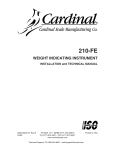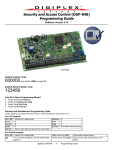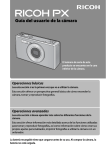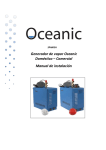Download Dremel 6000 Owner`s manual
Transcript
DM 2610919361 9/03 9/5/03 8:33 AM Page 1 Contour Sander Owner’s Manual Model 6000 HONESTLY NOW … Have you read this OWNER’S MANUAL? Parlez-vous français? Voir page 12 ¿Habla español? Vea página 23 • • • • • • • Safety Assembly Operation Maintenance Accessory Information Warranty Service Parts P.O. Box 1468 Racine, Wisconsin 53401 1-800-437-3635 http://www.dremel.com © Robert Bosch Tool Corporation 1997 all rights reserved Dremel brand products are manufactured and sold by the Dremel Division of Robert Bosch Tool Corporation 2610925476 10/04 Printed in Mexico DM 2610919361 9/03 9/5/03 8:33 AM Page 2 Power Tool Safety Rules ! WARNING Read and understand all instructions. Failure to follow all instructions listed below, may result in electric shock, fire and/or serious personal injury. SAVE THESE INSTRUCTIONS Damaged cords increase the risk of electric shock. Work Area Keep your work area clean and well lit. Cluttered benches and dark areas invite accidents. When operating a power tool outside, use an outdoor extension cord marked "W-A" or "W." These cords are rated for outdoor use and reduce the risk of electric shock. Refer to “Recommended sizes of Extension Cords” in the Accessory section of this manual. Do not operate power tools in explosive atmospheres, such as in the presence of flammable liquids, gases, or dust. Power tools create sparks which may ignite the dust or fumes. Keep by-standers, children, and visitors away while operating a power tool. Distractions can cause you to lose control. Personal Safety Stay alert, watch what you are doing and use common sense when operating a power tool. Do not use tool while tired or under the influence of drugs, alcohol, or medication. A moment of inattention while operating power tools may result in serious personal injury. Electrical Safety Double Insulated tools are equipped with a polarized plug (one blade is wider than the other.) This plug will fit in a polarized outlet only one way. If the plug does not fit fully in the outlet, reverse the plug. If it still does not fit, contact a qualified electrician to install a polarized outlet. Do not change the plug in any way. Double Insulation eliminates the need for the three wire grounded power cord and grounded power supply system. Before plugging in the tool, be certain the outlet voltage supplied is within the voltage marked on the nameplate. Do not use “AC only” rated tools with a DC power supply. Dress properly. Do not wear loose clothing or jewelry. Contain long hair. Keep your hair, clothing, and gloves away from moving parts. Loose clothes, jewelry, or long hair can be caught in moving parts. Keep handles dry, clean and free from oil and grease. Avoid accidental starting. Be sure switch is “OFF” before plugging in. Carrying tools with your finger on the switch or plugging in tools that have the switch “ON” invites accidents. Avoid body contact with grounded surfaces such as pipes, radiators, ranges and refrigerators. There is an increased risk of electric shock if your body is grounded. If operating the power tool in damp locations is unavoidable, a Ground Fault Circuit Interrupter must be used to supply the power to your tool. Electrician’s rubber gloves and footwear will further enhance your personal safety. Remove adjusting keys or wrenches before turning the tool “ON”. A wrench or a key that is left attached to a rotating part of the tool may result in personal injury. Do not overreach. Keep proper footing and balance at all times. Proper footing and balance enables better control of the tool in unexpected situations. Use safety equipment. Always wear eye protection. Dust mask, non-skid safety shoes, hard hat, or hearing protection must be used for appropriate conditions. Don't expose power tools to rain or wet conditions. Water entering a power tool will increase the risk of electric shock. Do not abuse the cord. Never use the cord to carry the tools or pull the plug from an outlet. Keep cord away from heat, oil, sharp edges or moving parts. Replace damaged cords immediately. Tool Use and Care Use clamps or other practical way to secure and support the workpiece to a stable platform. Holding the work by hand -2- DM 2610919361 9/03 9/5/03 8:33 AM Page 3 Do not force tool. Use the correct tool for your application. The correct tool will do the job better and safer at the rate for which it is designed. other condition that may affect the tools operation. If damaged, have the tool serviced before using. Many accidents are caused by poorly maintained tools. Develop a periodic maintenance schedule for your tool. Do not use tool if switch does not turn it “ON” or “OFF”. Any tool that cannot be controlled with the switch is dangerous and must be repaired. Use only accessories that are recommended by the manufacturer for your model. Accessories that may be suitable for one tool, may become hazardous or against your body is unstable and may lead to loss of control. when used on another tool. Disconnect the plug from the power source before making any adjustments, changing accessories, or storing the tool. Such preventive safety measures reduce the risk of starting the tool accidentally. Store idle tools out of reach of children and other untrained persons. Tools are dangerous in the hands of untrained users. Service Tool service must be performed only by qualified repair personnel. Service or maintenance performed by unqualified personnel could result in a risk of injury. For example: internal wires may be misplaced or pinched, safety guard return springs may be improperly mounted. Maintain tools with care. Keep cutting tools sharp and clean. Properly maintained tools, with sharp cutting edges are less likely to bind and are easier to control. Any alteration or modification is a misuse and may result in a dangerous condition. When servicing a tool, use only identical replacement parts. Follow instructions in the Maintenance section of this manual. Use of unauthorized parts or failure to follow Maintenance Instructions may create a risk of electric shock or injury. Certain cleaning agents such as gasoline, carbon tetrachloride, ammonia, etc. may damage plastic parts. Check for misalignment or binding of moving parts, breakage of parts, and any Contour Sander Safety Rules clothing must be worn by all persons entering the work area. Work area should be sealed by plastic sheeting and persons not protected should be kept out until work area is thoroughly cleaned. Unplug the sander before changing accessories. Accidental start-ups may occur if sander is plugged in while changing an accessory. If your tool is equipped with a dust bag, empty it frequently and after completion of sanding. Be extremely careful of dust disposal, materials in fine particle form may be explosive. Do not throw sanding dust on an open fire. Spontaneous combustion, may in time, result from mixture of oil or water with dust particles. Do not wet sand with this sander. Liquids entering the motor housing is an electrical shock hazard. Do not use sandpaper intended for larger sanding pads. Larger sandpaper will extend beyond the sanding pad causing snagging, tearing of the paper or kick-back. Extra paper extending beyond the sanding pad can also cause serious lacerations. Always wear eye protection and a dust mask for dusty applications and when sanding overhead. Sanding particles can be absorbed by your eyes and inhaled easily and may cause health complications. Clamp or secure workpiece when sanding. Clamping the workpiece prevents it from being ejected from under the sander and leaves both hands free to control the tool. Use special precautions when sanding chemically pressure treated lumber, paint that may be lead based, or any other materials that may contain carcinogens. A suitable breathing respirator and protective Keep the cord away from the accessory. The cord can become entangled with the pad or contour. -3- DM 2610919361 9/03 9/5/03 8:33 AM Page 4 Some dust created by • Arsenic and chromium from chemicallytreated lumber. ! WARNING power sanding, sawing, grinding, drilling, and other construction activities contains chemicals known to cause cancer, birth defects or other reproductive harm. Some examples of these chemicals are: Your risk from these exposures varies, depending on how often you do this type of work. To reduce your exposure to these chemicals: work in a well ventilated area, and work with approved safety equipment, such as those dust masks that are specially designed to filter out microscopic particles. • Lead from lead-based paints, • Crystalline silica from bricks and cement and other masonry products, and -4- DM 2610919361 9/03 9/5/03 8:33 AM Page 5 Symbols IMPORTANT: Some of the following symbols may be used on your tool. Please study them and learn their meaning. Proper interpretation of these symbols will allow you to operate the tool better and safer. Symbol Name Designation/Explanation V Volts Voltage (potential) A Amperes Current Hz Hertz Frequency (cycles per second) W Watt Power kg Kilograms Weight min Minutes Time s Seconds Time Diameter Size of drill bits, grinding wheels, etc. No load speed Rotational speed, at no load n0 .../min 0 1, 2, 3, ... I, II, III, 0 Revolutions or reciprocation per minute Revolutions, strokes, surface speed, orbits etc. per minute Off position Zero speed, zero torque... Selector settings Speed, torque or position settings. Higher number means greater speed Infinitely variable selector with off Speed is increasing from 0 setting Arrow Action in the direction of arrow Alternating current Type or a characteristic of current Direct current Type or a characteristic of current Alternating or direct current Type or a characteristic of current Class II construction Designates Double Insulated Construction tools. Earthing terminal Grounding terminal Warning symbol Alerts user to warning messages Ni-Cad RBRC seal Designates Ni-Cad battery recycling program This symbol designates that this tool is listed to Canadian Standards by Underwriters Laboratories. This symbol designates that this tool is listed by Underwriters Laboratories. This symbol designates that this tool is listed by Underwriters Laboratories, and listed to Canadian Standards by Underwriters Laboratories. This symbol designates that this tool is listed by the Canadian Standards Association. -5- This symbol designates that this tool complies to NOM Mexican Standards. DM 2610919361 9/03 9/5/03 8:33 AM Page 6 Functional Description and Specifications Disconnect the plug from the power source before making any ! WARNING assembly, adjustments or changing accessories. Such preventive safety measures reduce the risk of starting the tool accidentally. Contour Sander FIG. 1 POWER CORD MOTOR BRUSHES VENTILATION OPENINGS ON/OFF SWITCH VARIABLE SPEED SWITCH GRIP DIMPLES RELEASE LEVER SANDING TUBE CLAMP HOLDER CONTOUR RUBBER GRIP RING DETAIL PAD HOOK & LOOP PAPER See diagram for proper way to hold tool. The head of sander will get warm as it is being used. Please use care to make sure ventilation openings are not covered during use. VENTILATION OPENINGS WARM AREA NOTE: For tool specifications refer to the nameplate on your tool. -6- DM 2610919361 9/03 9/5/03 8:33 AM Page 7 Operating Instructions ON/OFF AND VARIABLE SPEED SWITCHES Your Sander is equipped with a variable speed switch and a separate on/off switch. The speed can be controlled from minimum to maximum speed by moving the switch lever to desired setting. TO TURN TOOL “ON”: Slide switch to the “ON”position (I) on symbol. TO TURN TOOL “OFF” Slide switch to the “OFF” position (0) off symbol. TO INCREASE SPEED: Move variable speed control lever toward the + sign. TO DECREASE SPEED: Move variable speed control lever toward the – sign. Setting Material/Application Low Delicate surfaces, veneers, or light surface finishing & polishing Low Plastics or other soft surfaces Medium Solid wood, fast stock removal, paint removal High General use, metal sanding & finishing, chipboard, coarse sanding on rough surfaces, & polishing 5. Press holder firmly back up into place until the pad "snaps" into position. SELECTING A CONTOUR SHAPE Individual contour shapes are available in three basic styles. A variety of radiuses are available in each style: To remove pad, rotate lever to release and lower the clamp holder. Remove the pad from the holder. You are now ready to install another pad or contour shape. Convex shapes: 1/8", 3/16", 1/4", 3/8", 1/2", 5/8" Concave shapes: 1/8", 3/16", 1/4", 3/8", 1/2", 5/8" When using detail sanding pads, regularly rotate the pad 180 degrees to maximize all surfaces for longer, more efficient use. Angled shapes: Flat, 30°, 60°, 45°, 90°, -90° The contour shapes are available in a variety of different radiuses to match common configurations. Additionally, each contour can be modified or customized by trimming or shaping the material to the desired form. INSTALLING AND REMOVING CONTOURS To attach a contour shape to the sander: INSTALLING AND REMOVING DETAIL PAD & OPTIONAL SHUTTER PAD Your sander is equipped with a quick change clamping mechanism that allows you to easily change accessories without additional tools. 2. Rotate red release lever to lower the accessory clamp holder. 1. Disconnect sander from power source. 3. Apply either a sanding tube or pressure sensitive adhesive directly to contour shape. 4. Insert contour completely into the top and back of the holder until it reaches the rear "stop" (Fig. 2). To attach detail pad or optional shutter pad to the sander: 1. Disconnect sander from power source. CONTOUR 2. Rotate red release lever to lower the accessory clamp holder. 3. Apply hook and loop backed sandpaper to pad. FIG. 2 CLAMP HOLDER 4. Insert pad completely into the top and back of the holder until it reaches the rear "stop". REAR STOP HINT: Make sure the small grip dimples have firmly secured the rubber grip ring (Fig. 1). RELEASE LEVER -7- DM 2610919361 9/03 9/5/03 8:33 AM Page 8 Operating Instructions (cont.) Hint: make sure the small grip dimples have firmly secured the sandpaper surface. 5. Press holder firmly back up into place until the contour "snaps" in place. To remove contour, rotate lever to release and lower the clamp holder. You are now ready to install another contour shape or detail pad. When using sanding tubes, rotate them regularly to maximize all surfaces for longer, more efficient use. HINT: When reaching into extremely tight places, the contour can be extended beyond the front of the tool. NOTE: DO NOT APPLY EXCESSIVE PRESSURE TO THE TOOL WHILE IN USE. ALLOW THE SPEED OF THE TOOL AND THE ACCESSORY TO DO THE WORK. APPLYING UNNECESSARY PRESSURE WILL CAUSE THE ACCESSORY TO WEAR UNEVENLY - IT WILL NOT SERVE TO PERFORM THE WORK MORE QUICKLY. “Accessory Tips” Contours: Use sanding tubes that are long lasting, reusable and easy to install. To install, slide tube completely over desired contour, and shape paper to contour. Contour abrasive tubes can also be rotated on the contour, to maximize the use of the abrasive surface. NOTE: The contour shapes have been extruded to the dimension indicated on the shape. When doing exacting work, it will be necessary to provide an allowance for the sandpaper being used. Heavier/coarser grit papers require a greater allowance. PSA Adhesives work best at temperatures above 25 degrees F. If PSA abrasives and pads are stored at lower temperatures, it may be necessary to allow them to come to room temperature before use. PSA Rolls: Rolls with pressure sensitive adhesive can also be used with individual contours. Unroll a strip of abrasive to fit the particular contour, and cut to length with scissors. When using pressure sensitive adhesive, optimal clamping can be obtained if the entire contour surface is wrapped with paper. Firmly press the abrasive in place on the contour. To remove abrasive, lift a corner of the sheet with your fingernail and peel it off. Dispose of the used abrasives, they are not reusable. PSA Rolls must be stored in a dust-free environment to prevent contamination of adhesive. After considerable use, the detail pad backing surface may become worn. The backing pad must be replaced when it no longer offers a firm grip. If you are experiencing premature wearout of the backing pad facing, decrease the amount of pressure you are applying during operation of the tool. HINT: When using 1/8" and 3/16" concave contours with sanding tubes, it will be easier to conform the abrasive to the workpiece if a finer grit paper is used. “Tool Tips” Always be certain that smaller workpieces are securely fastened to a bench or other support. Larger panels may be held in place by hand on a bench or sawhorse. SANDING: Open-coat aluminum oxide sanding sheets are recommended for most wood or metal sanding applications, as this synthetic material cuts quickly and wears well. This machine is particularly suitable for access to corners and edges that are otherwise difficult to reach or require hand sanding. Profiles and grooves may be finished using the tip or edge of the selected accessory, which should occasionally be rotated during use to distribute the wear on the accessory or backing pad surface. -8- DM 2610919361 9/03 9/5/03 8:33 AM Page 9 SELECTING ABRASIVES The following suggestions may be used as a general guide for abrasive selection, but the best results will be obtained by sanding a test sample of the workpiece first. Grit Coarse 80 grit Medium 120 grit Extra fine 220 grit Application For rough wood, metal sanding, rust, paint, or old material removal. For general wood or metal sanding. For final sanding of bare wood, smoothing old paint, or preparing a finished surface for recoating. With the workpiece firmly secured, turn tool “ON”. Contact the work with the tool after the sander has reached the selected speed, and remove it from the work before switching the tool “OFF”. Operating your sander in this manner will prolong switch and motor life, and greatly increase the quality of your work. Your contour sander uses an in-line sanding motion. The best surface finish will be achieved while operating the sander in-line with the wood grain. Faster stock removal can be achieved by operating the sander across the grain when working out rough areas, then finishing by sanding with the grain. DO NOT APPLY EXCESSIVE PRESSURE — LET THE TOOL DO THE WORK. EXCESSIVE PRESSURE WILL RESULT IN POOR HANDLING, VIBRATION, AND UNWANTED SANDING MARKS. If the surface is rough, begin with coarser grits and then complete the surfacing with medium and fine abrasives. To avoid uneven results, do not skip more than one grit size when going from coarser to finer, and do not sand in one area for too long. When the job is completed, gently lift the tool from the work surface and slide switch to the "OFF" position. To ensure longer life and even wear, lightly brush any residue or clogged materials from sandpaper surface prior to each use. Do not wet sand with this ! WARNING sander. Maintenance caps one at a time with a small screwdriver by rotating cap counter-clockwise and check each brush. If the brush is less than 1/8" long and the end surface of the brush that contacts the commutator is rough and/or pitted, they should be replaced. Check both brushes. Usually the brushes will not wear out simultaneously. If one brush is worn out, replace both brushes. Make sure the brushes are installed as illustrated. The curved surface of the brush must match the curvature of the commutator. Service Preventive maintenance ! WARNING performed by unauthorized personnel may result in misplacing of internal wires and components which could cause serious hazard. We recommend that all tool service be performed by a Dremel Service Facility. CARBON BRUSHES The brushes and commutator in your tool have been engineered for many hours of dependable service. To maintain peak efficiency of the motor, we recommend every two to six months the brushes be examined. Only genuine Dremel replacement brushes specially designed for your tool should be used. CURVED END OF BRUSH MUST MATCH CURVATURE OF HOUSING MAINTENANCE OF REPLACEABLE BRUSHES #5090930 The brushes should be inspected frequently when tools are used continuously. If your tool runs sporadically, loses power, makes unusual noises or runs at a reduced speed, check the brushes. To continue using the tool in this condition will permanently damage your tool. BRUSH WASHER CURVATURE OF HOUSING BRUSH SPRING BRUSH CAP With the cord unplugged, remove the brush -9- DM 2610919361 9/03 9/5/03 8:33 AM Page 10 After replacing brushes the tool should be run at no-load; place on a clean surface and run freely for 5 minutes before loading (or using) the tool. This will allow the brushes to “seat” properly and will give you more hours of life from each set of brushes. This will also extend the total life of your tool since the commutator surface will “wear” longer. TOOL LUBRICATION Your Dremel tool has been properly lubricated and is ready to use. Under normal use no additional lubrication is required. Cleaning To avoid accidents always ! WARNING disconnect the tool from the power supply before cleaning or performing any maintenance. The tool may be cleaned most effectively with compressed dry air. Always wear safety goggles when cleaning tools with compressed air. Ventilation openings and switch levers must be kept clean and free of foreign matter. Do not attempt to clean by inserting pointed objects through openings. ! parts. Some of these are: gasoline, carbon tetrachloride, chlorinated cleaning solvents, ammonia and household detergents that contain ammonia. If an extension cord is RECOMMENDED SIZES OF EXTENSION CORDS 120 VOLT ALTERNATING CURRENT TOOLS ! WARNING necessary, a cord with adequate size conductors that is capable of carrying the current necessary for your tool must be used. This will prevent excessive voltage drop, loss of power or overheating. Grounded tools must use 3-wire extension cords that have 3-prong plugs and receptacles. Tool’s Ampere Rating 3-6 6-8 8-10 10-12 12-16 NOTE: The smaller the gauge number, the heavier the cord. Your Contour Sander can be equipped with an optional dust collection wand. This device is effective in sanding pad dust collection when used with a shop vacuum with hose dimensions of ID 1-1/2” or OD 1-3/8” or an appropriate adapter to fit (see diagram on page 31). When using the wand, be sure to align the sanding sheet holes with the holes in the sanding pad to allow the dust wand to function properly. The detail pad (and optional shutter pad) can be used with hook/loop sandpaper with or without holes for dust collection. If you’ve #6017 1/8" #6018 3/16" #6019 1/4" #6020 3/8" Certain cleaning agents and CAUTION solvents damage plastic Cord Size in A.W.G. Wire Sizes in mm2 Cord Length in Feet Cord Length in Meters 25 50 100 150 15 30 60 120 18 18 18 16 14 16 16 16 16 12 16 14 14 14 — .75 .75 .75 1.0 — .75 1.0 1.0 2.5 — 1.5 2.5 2.5 4.0 — 2.5 4.0 4.0 — — 14 12 12 12 — purchased sandpaper without holes, holes can be punched manually for use with the dust wand. Using sandpaper with holes - while not using the dust wand - will not harm or damage your work. This sander will operate effectively with or without the dust collection system. To order individual contours (below), or for additional information about the dust collection feature, call Dremel Customer Service @ 1-800-437-3635. #6021 1/2" #6022 5/8" #6023 1/8" #6024 3/16" #6025 1/4" Radius #6026 3/8" #6027 1/2" #6028 5/8" #6029 Flat #6030 30º -10- #6031 45º #6032 60º #6033 90º #6034 90º DM 2610919361 9/03 9/5/03 8:33 AM Page 11 Dremel Limited Warranty Your Dremel product is warranted against defective material or workmanship for a period of two years from date of purchase. In the event of a failure of a product to conform to this written warranty, please take the following action: 1. DO NOT return your product to the place of purchase. 2. Carefully package the product by itself, with no other items, and return it, freight prepaid, along with: A. A copy of your dated proof of purchase (please keep a copy for yourself). B. A written statement about the nature of the problem. C. Your name, address and phone number to: UNITED STATES Dremel Service Center 4915 Twenty-First Street Racine, Wisconsin 53406 Dremel Service Center 4631 E. Sunny Dunes Palm Springs, CA 92264 OR CANADA Giles Tool Agency 6520 Lawrence Av. East Scarborough, Ont. Canada M1C 4A7 OUTSIDE CONTINENTAL UNITED STATES See your local distributor or write to Dremel, 4915 Twenty-First St. Racine, Wisconsin 53406 We recommend that the package be insured against loss or in transit damage for which we cannot be responsible. This warranty applies only to the original registered purchaser. DAMAGE TO THE PRODUCT RESULTING FROM TAMPERING, ACCIDENT, ABUSE, NEGLIGENCE, UNAUTHORIZED REPAIRS OR ALTERATIONS, UNAPPROVED ATTACHMENTS OR OTHER CAUSES UNRELATED TO PROBLEMS WITH MATERIAL OR WORKMANSHIP ARE NOT COVERED BY THIS WARRANTY. No employee, agent, dealer or other person is authorized to give any warranties on behalf of Dremel. If Dremel inspection shows that the problem was caused by problems with material or workmanship within the limitations of the warranty, Dremel will repair or replace the product free of charge and return product prepaid. Repairs made necessary by normal wear or abuse, or repair for product outside the warranty period, if they can be made, will be charged at regular factory prices. DREMEL MAKES NO OTHER WARRANTY OF ANY KIND WHATEVER, EXPRESSED OR IMPLIED, AND ALL IMPLIED WARRANTIES OF MERCHANTABILITY AND FITNESS FOR A PARTICULAR PURPOSE WHICH EXCEED THE ABOVE MENTIONED OBLIGATION ARE HEREBY DISCLAIMED BY DREMEL AND EXCLUDED FROM THIS LIMITED WARRANTY. This warranty gives you specific legal rights and you may also have other rights which vary from state to state. The obligation of the warrantor is solely to repair or replace the product. The warrantor is not liable for any incidental or consequential damages due to any such alleged defect. Some states do not allow the exclusion or limitation of incidental or consequential damages, so the above limitations or exclusion may not apply to you. For prices and warranty fulfillment in the continental United States, contact your local Dremel distributor. Exportado por: Robert Bosch Tool Corporation Mt. Prospect, IL 60056 -2230, E.U.A. Importado en México por: Robert Bosch, S.A. de C.V., Calle Robert Bosch No. 405, Zona Industrial, Toluca, Edo. de México, C.P. 50070, Tel. (722) 2792300 -11-












